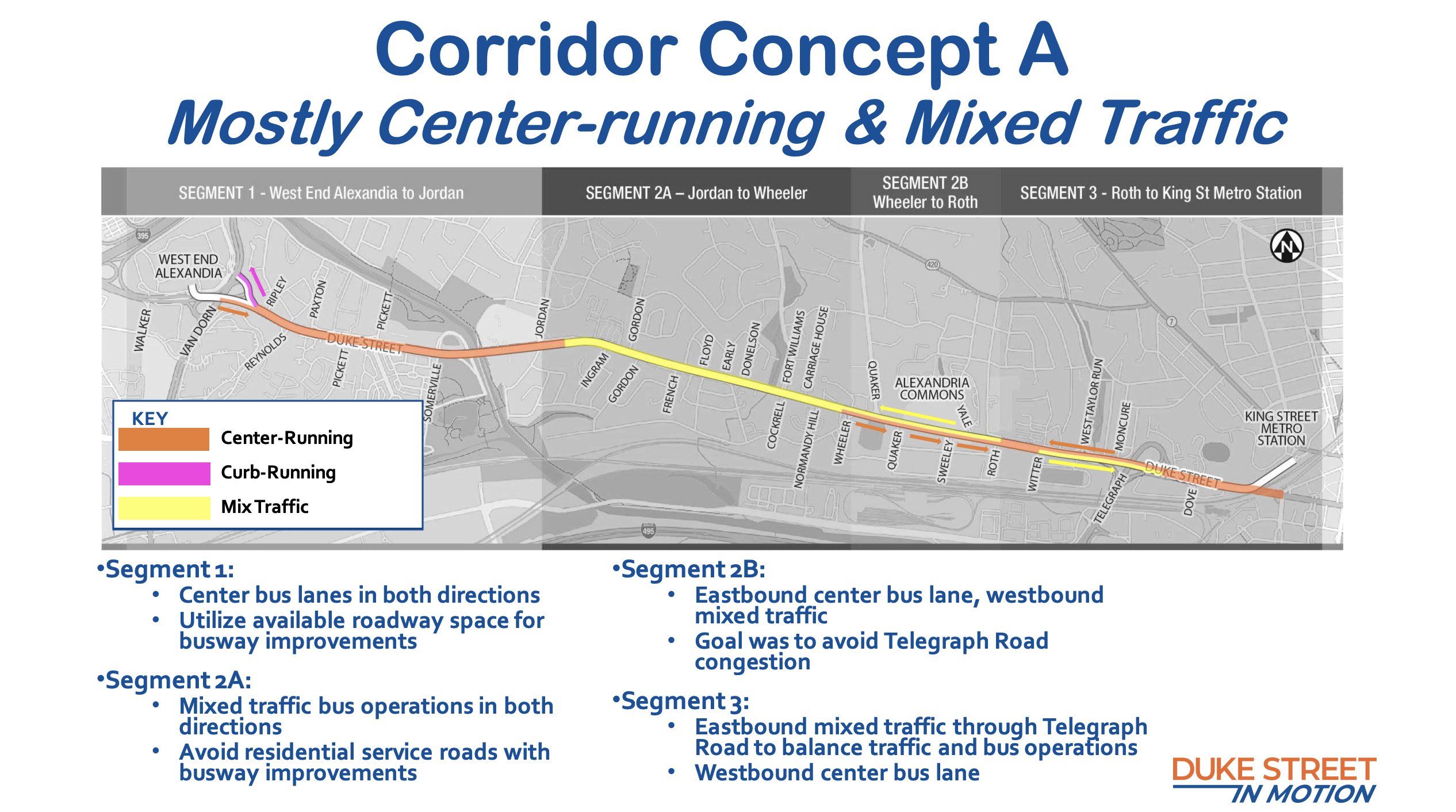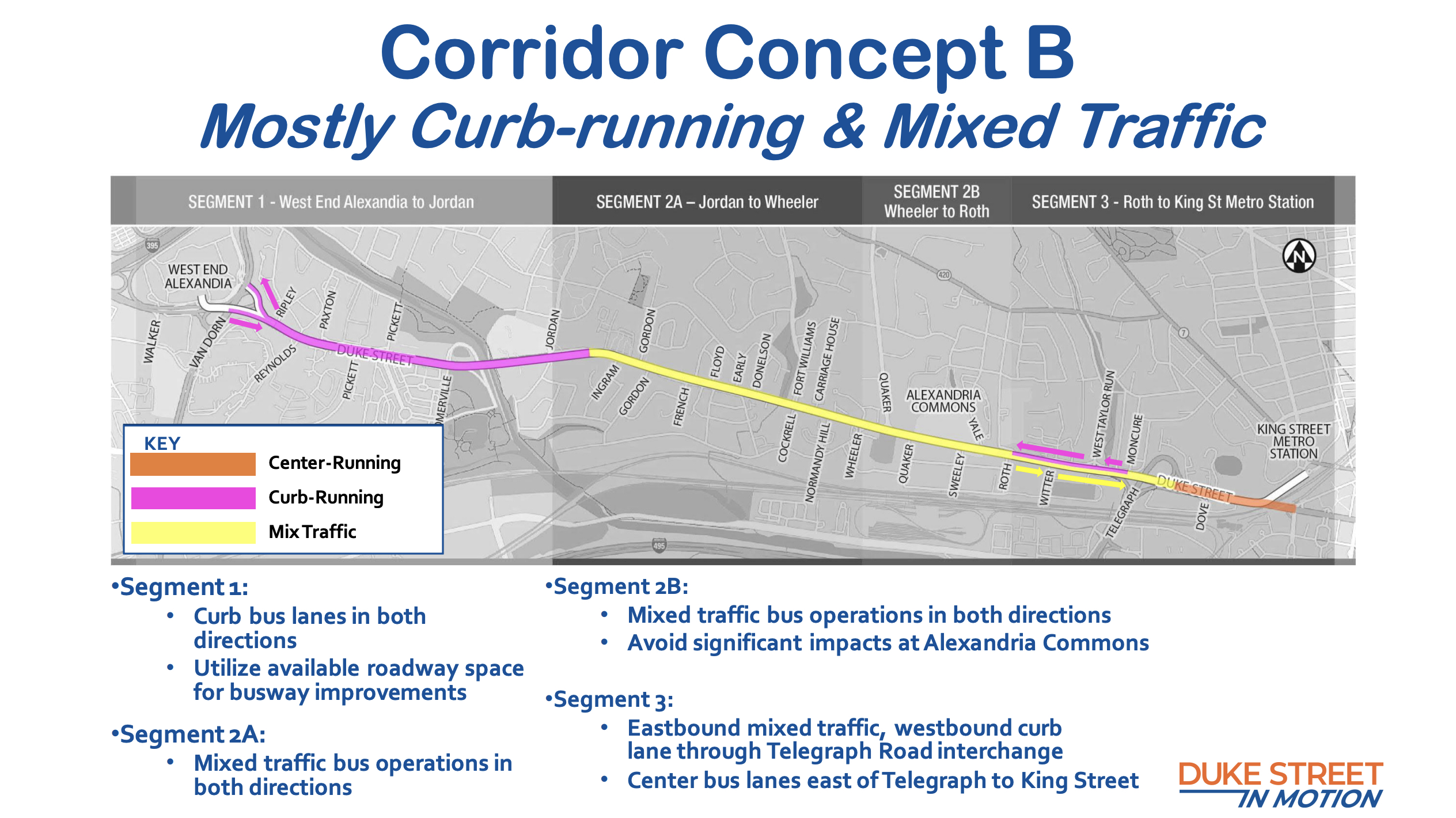Thursday, April 20, 2023
Duke Street is about to get a makeover, although the contours of its future are still in doubt.
At issue is a controversial proposal to remove two traffic lanes on Duke Street to create dedicated lanes for bus rapid transit, a move designed to reduce single-occupancy vehicles and offer enhanced transit service. Members of the Alexandria City Council are expected to vote on the proposal on June 27, which means the next few weeks will be the final opportunity for residents to weigh in on plans that have been in the works since 2008.
"Even if you don't take a bus, this is still an important project for you," said Hillary Orr, deputy director of the Department of Transportation and Environmental Services. "We're trying to think about the larger community and how we can all work together to have a transportation system that works for everybody and gives people options."
Bus service along the Duke Street corridor has the highest ridership in the city, which is one of the reasons city officials are focused on enhancing service for people who might not own a car. Although ridership declined during the pandemic, the latest numbers from DASH show that service along Duke Street is now more popular than it was before 2020. That's why one of the stated goals for the new transitway is to enhance bus service, giving people options other than single-occupancy vehicles that create traffic congestion and carbon emissions.
"A winning regional strategy is not to make it harder for people to use their single-occupancy vehicles. The winning strategy is to make is easier for people to move around using a multitude of options," said John Hillegass, director of regional mobility and infrastructure for the Greater Washington Partnership. "Unfortunately right now we have a mismatch between the infrastructure we have to support other options and the infrastructure for single-occupancy vehicles."
THE HISTORY of bus-rapid transit in Alexandria dates back to 2008, when the Alexandria City Council ditched the 1992 transportation plan in favor of a new document declaring that everyone in Alexandria should have the opportunity "to choose, on a daily basis, if they want to walk, bike or take transit to their destination." The plan identified three transit corridors: Route One, Duke Street and Beauregard Street. The vote on the 2008 Transportation Master Plan was unanimous, but then the cold, hard reality of losing traffic lanes set in and people started questioning the wisdom of dedicated bus lanes.
“I’m not convinced Duke Street needs this right now,” said then-Councilman Frank Fannon in 2011. “We could start building transit corridors everywhere, but is that justifiable?”
Despite opposition, city leaders moved forward with plans to create the region's first dedicated bus lanes along the Route One corridor. The 4.5-mile stretch of roadway included some of the most congested streets in the region, which now feature blue Metroway buses operated by Washington Metropolitan Area Transit Authority. The bus-rapid transit vehicles feature off-board fare collection and multiple points of access. At the time, city officials heralded the new dedicated lanes as the future of transit in the region.
"Because it's in dedicated lanes, and typically those lanes are concrete, the suspension on these vehicles is tighter," said Rich Baier, who was director of the Alexandria Department of Transportation and Environmental Services at the time. "It's a smoother ride."
Now City Council members are considering the next step in that 2008 master plan, rethinking the Duke Street corridor. City officials point out a few important distinctions between the Route One corridor and the Duke Street corridor, perhaps most notably the existing demand for bus service on Duke Street. The Route 30 DASH bus along Duke Street is currently the most popular route in the city, so enhancing service here will help people who already rely on this service to navigate their way through the city. And unlike the Route One corridor, the Duke Street corridor does not run parallel to an existing Metro line. That means the need for transit service on Duke Street is much greater than it ever was on Route One.
"I had an opportunity to sit in on one of the meetings a couple of weeks ago, and the residents were very pleased," said Councilman Canek Aguirre during a February discussion of the transit corridor. "I think this is another good example of where the staff is listening to the community and that we are working together to see this project to fruition."

THE OPTIONS now under consideration include a variety of ways to enhance bus service along Duke Street. The option that would involve the least amount of change would be an option for the buses to use traffic lanes along with all the other vehicles on the street. From a transit perspective, this would be the least efficient way to move people through the city because it would not allow the buses to bypass cars stuck in bumper-to-bumper traffic gridlock. The option that would maximize transit potential would have dedicated bus lanes from Landmark to Jordan Street as well as parts of Duke Street from Quaker Lane to the King Street Metro station. Aside from removing two travel lanes from Duke Street, this option would also remove several left-turn lanes forcing drivers into using u turns to arrive at their destination.
"One of the big challenges with Duke Street that I think most people agree on is that people don't like it the way it is," said Orr. "There's a lot of congestion, and it is also one of our highest crash corridors in the city."
Aside from making a decision about whether Duke Street needs dedicated bus lanes, City Council members will also determine what kind of sidewalks and bike lanes are available along the corridor. One option has a shared use path along most of the corridor, forcing pedestrians to share a path with motorized scooters and cyclists. Another option creates a designated cycle track that would allow motorized vehicles and cyclists to have their own lanes from Landmark to Jordan Street and from Roth Street to Telegraph Road. For many people, the idea of creating a cycle track along parts of Duke Street is resurrecting some of the toxic politics around the debate over bike lanes on Seminary Road.
"Being a veteran of some of the bike lane conversations, I thought our position was to not do that," said Councilman John Taylor Chapman.